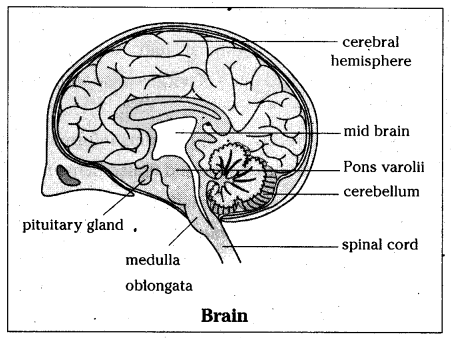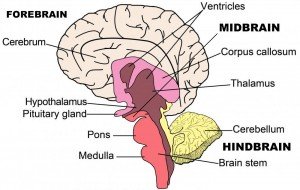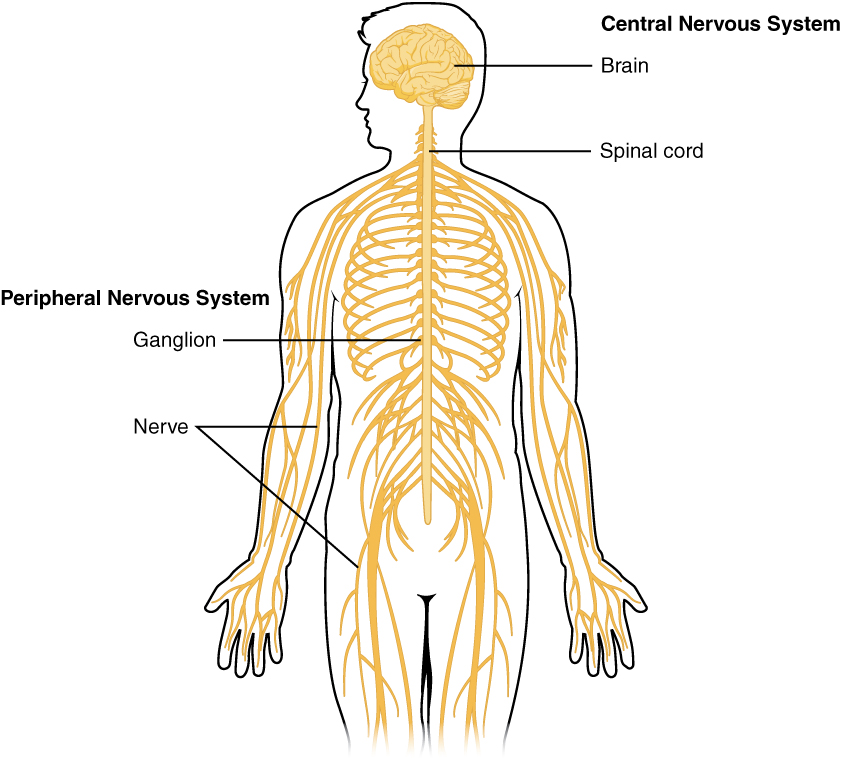The human nervous system can be categorised to
Central nervous system(cns)
Peripherial nervous system(pns)
Central nervous system :it is the integrating and command centre of the nervous system which consists of the brain and spinal cord(as discussed earlier)
Brain: the brain is the central information processing organ of our body and acts as the 'command and control system' of all body activities
It controls the following activities
The voluntary movements and balance of the body.
Functioning of vital involuntary organs,e.g, lungs,heart,kidneys,etc.
Thermoregulation, hunger and thirst.
Circardian(24hrs) rhythms of our body.
Activities of several endocrine glands and human behaviour.
It is also the site forprocessing of vision, hearing, speech, memory, intelligence, emotions and thoughts.
Location
The brain is the anteriormost part of the central neural system, which is located in the crainium( cranial cavity) of the skull.
Protective covering of the brain
It is covered by three membranes or meanings ( cranial meanings)
The outermost membrane, the duramater is the tough fibrous membrane adhering close to the inner side of the skull.
The middle membrane, is very thin layer called arachnoid membrane ( arachnoid matar).
The inner most membrane ,the piameter is thin, very delicate, which is in contact with the brain tissue.
The human brain weights from 1200_1400g. Brain alone has about 2 billion neurons and trillions of interneuron connections.
Structure
The human brain is divisble into three main parts
(1) forebrain (2) midbrain (3) hindbrain
(1)forebrain
The forebrain consists of
Olfactory lobe : the anterior part of the brain is formed by a pair of short club shaped structures ,the olfactory lobes. These are concerned with the same of smell.
Cerebrum: it is the largest and most complex of all the parts of the human brain. A deep cleft divides the cerebrum longitudinally into two equal halves. These are termed as the left and right cerebral hemispheres. These hemispheres are connected by a large band of myelinated fibres the corpus callosum.
The outer cover of cerebral hemisphere is called cerebral cortex.
The cerebral cortex is greatly folded. The upward folds, gyri,alternate with the downward grooves or sulci. The larger concentration of medullated nerve fibres gives this tissue an. apaque white appearance. Hence,it is called the white matter.
Lobes: a very deep longitudinal fissure , seprates the two cerebral hemispheres. Each cerebral hemisphere of the cerebrum is divided into four lobes i.e. frontal,parietal, temporal and occipital lobes.
In each cerebral hemisphere, there are three types of functional areas
Sensory areas it receives impulses from the receptors and motor areas transmit impulses to the effectors.
Association areas these are large regions that are neither clearly sensory nor moter in junction .
Diencephalon: is the posterio_ ventral part of the fore brain .
(2)midbrain
The midbrain is located between the thalamus hypotthalamus of the forebrain and pons of the hindbrain. A canal called the cerebral aqueduct passes through the midbrain.
The dorsal portion of the midbrain mainly cinsists of two pairs ( i.e four) of rounded swellings( lobes) called corpora quadrigemina.
(3) hindbrain
The hindbrain consists of
(a) pons consists of fibre tracts that interconnect different regions of the brain.
(b)cerebellum is the second largest part of the human brain (means first being the cerebrum).it has very convolulated surface in order to provide the ad
ditional space for many more neurons.
(c)medulla (oblongata) is connected to the spinal cord and contains centres, which control respiratory rhythem, cardiovascular reflexes, gastric secretions and the postural gastures of the bidy( vertigo).
Spinal cord
(1) it forms the posterior part of the cns, running mid _ dorsally in the neural canal of the vertebral column. In an adult, the spinal cord is about 42_45cm long. Its diameter varies at different stages of growth.
(2) the spinal cord is formed of two types of nervous tissue, i.e grey matter and white matter.
(3) the gray matter sorrounded by white matter . it is consisted of groups of myelinated axons.
(4) spinal cord conducts impulses to and firm the brain and controls most of the reflex activities.